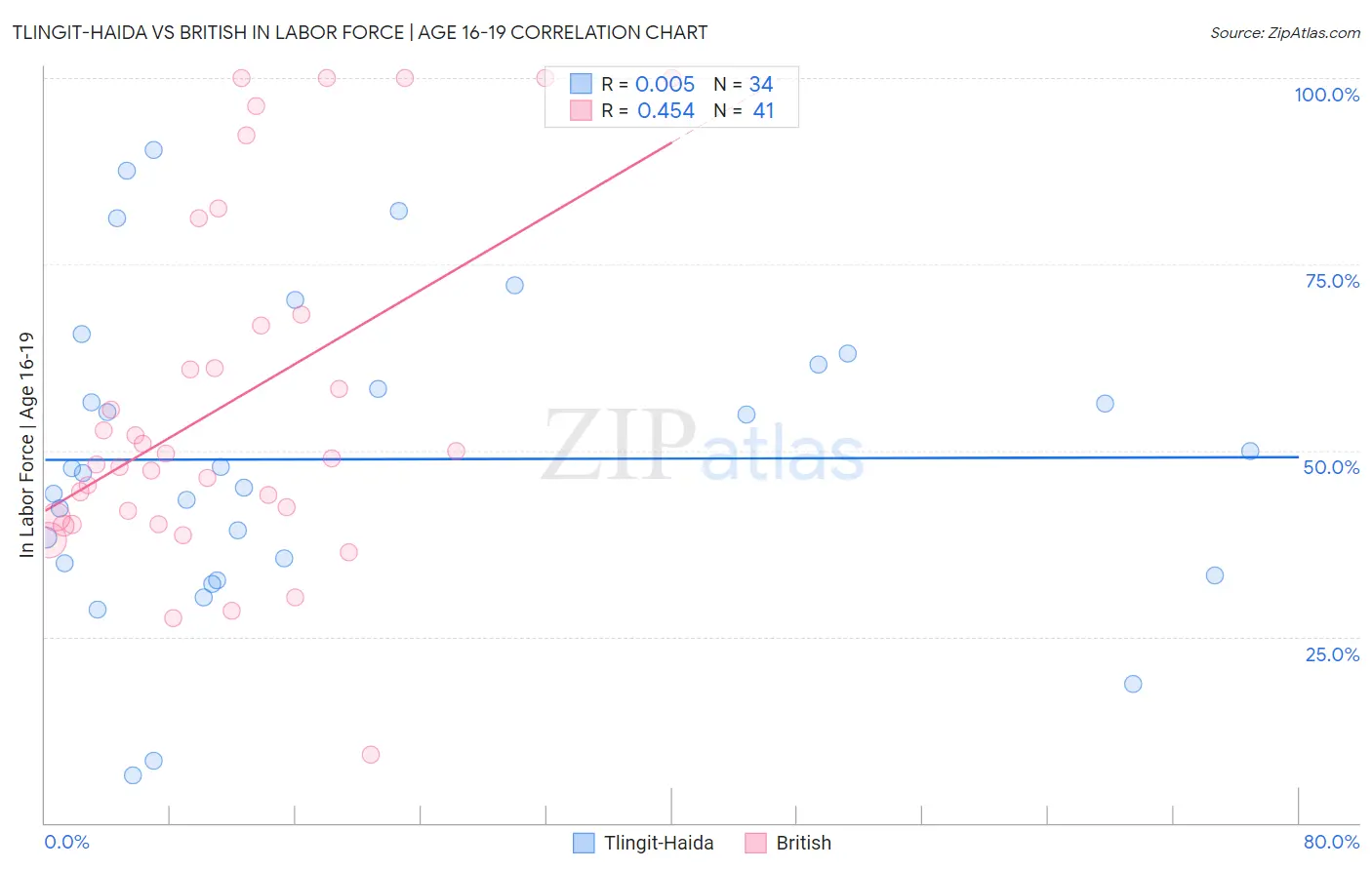Tlingit-Haida vs British In Labor Force | Age 16-19
COMPARE
Tlingit-Haida
British
In Labor Force | Age 16-19
In Labor Force | Age 16-19 Comparison
Tlingit-Haida
British
40.5%
IN LABOR FORCE | AGE 16-19
100.0/ 100
METRIC RATING
54th/ 347
METRIC RANK
40.5%
IN LABOR FORCE | AGE 16-19
100.0/ 100
METRIC RATING
55th/ 347
METRIC RANK
Tlingit-Haida vs British In Labor Force | Age 16-19 Correlation Chart
The statistical analysis conducted on geographies consisting of 60,837,645 people shows no correlation between the proportion of Tlingit-Haida and labor force participation rate among population between the ages 16 and 19 in the United States with a correlation coefficient (R) of 0.005 and weighted average of 40.5%. Similarly, the statistical analysis conducted on geographies consisting of 529,284,703 people shows a moderate positive correlation between the proportion of British and labor force participation rate among population between the ages 16 and 19 in the United States with a correlation coefficient (R) of 0.454 and weighted average of 40.5%, a difference of 0.030%.

In Labor Force | Age 16-19 Correlation Summary
| Measurement | Tlingit-Haida | British |
| Minimum | 6.4% | 9.1% |
| Maximum | 90.3% | 100.0% |
| Range | 83.9% | 90.9% |
| Mean | 48.8% | 56.2% |
| Median | 47.3% | 48.9% |
| Interquartile 25% (IQ1) | 34.8% | 40.6% |
| Interquartile 75% (IQ3) | 61.5% | 67.6% |
| Interquartile Range (IQR) | 26.7% | 27.0% |
| Standard Deviation (Sample) | 20.5% | 23.4% |
| Standard Deviation (Population) | 20.2% | 23.1% |
Demographics Similar to Tlingit-Haida and British by In Labor Force | Age 16-19
In terms of in labor force | age 16-19, the demographic groups most similar to Tlingit-Haida are Immigrants from Kenya (40.5%, a difference of 0.030%), Fijian (40.4%, a difference of 0.12%), Lithuanian (40.4%, a difference of 0.14%), Aleut (40.4%, a difference of 0.16%), and Slavic (40.4%, a difference of 0.29%). Similarly, the demographic groups most similar to British are Immigrants from Kenya (40.5%, a difference of 0.060%), Fijian (40.4%, a difference of 0.090%), Lithuanian (40.4%, a difference of 0.11%), Aleut (40.4%, a difference of 0.13%), and Slavic (40.4%, a difference of 0.26%).
| Demographics | Rating | Rank | In Labor Force | Age 16-19 |
| Europeans | 100.0 /100 | #44 | Exceptional 41.1% |
| Croatians | 100.0 /100 | #45 | Exceptional 41.1% |
| Immigrants | Sudan | 100.0 /100 | #46 | Exceptional 41.0% |
| Carpatho Rusyns | 100.0 /100 | #47 | Exceptional 40.8% |
| Icelanders | 100.0 /100 | #48 | Exceptional 40.8% |
| Cree | 100.0 /100 | #49 | Exceptional 40.8% |
| Indonesians | 100.0 /100 | #50 | Exceptional 40.7% |
| Immigrants | Zaire | 100.0 /100 | #51 | Exceptional 40.7% |
| Immigrants | Laos | 100.0 /100 | #52 | Exceptional 40.6% |
| Immigrants | Kenya | 100.0 /100 | #53 | Exceptional 40.5% |
| Tlingit-Haida | 100.0 /100 | #54 | Exceptional 40.5% |
| British | 100.0 /100 | #55 | Exceptional 40.5% |
| Fijians | 100.0 /100 | #56 | Exceptional 40.4% |
| Lithuanians | 100.0 /100 | #57 | Exceptional 40.4% |
| Aleuts | 100.0 /100 | #58 | Exceptional 40.4% |
| Slavs | 100.0 /100 | #59 | Exceptional 40.4% |
| Immigrants | Eastern Africa | 100.0 /100 | #60 | Exceptional 40.4% |
| Americans | 100.0 /100 | #61 | Exceptional 40.3% |
| Cherokee | 100.0 /100 | #62 | Exceptional 40.2% |
| Northern Europeans | 100.0 /100 | #63 | Exceptional 40.2% |
| Immigrants | Micronesia | 100.0 /100 | #64 | Exceptional 40.2% |